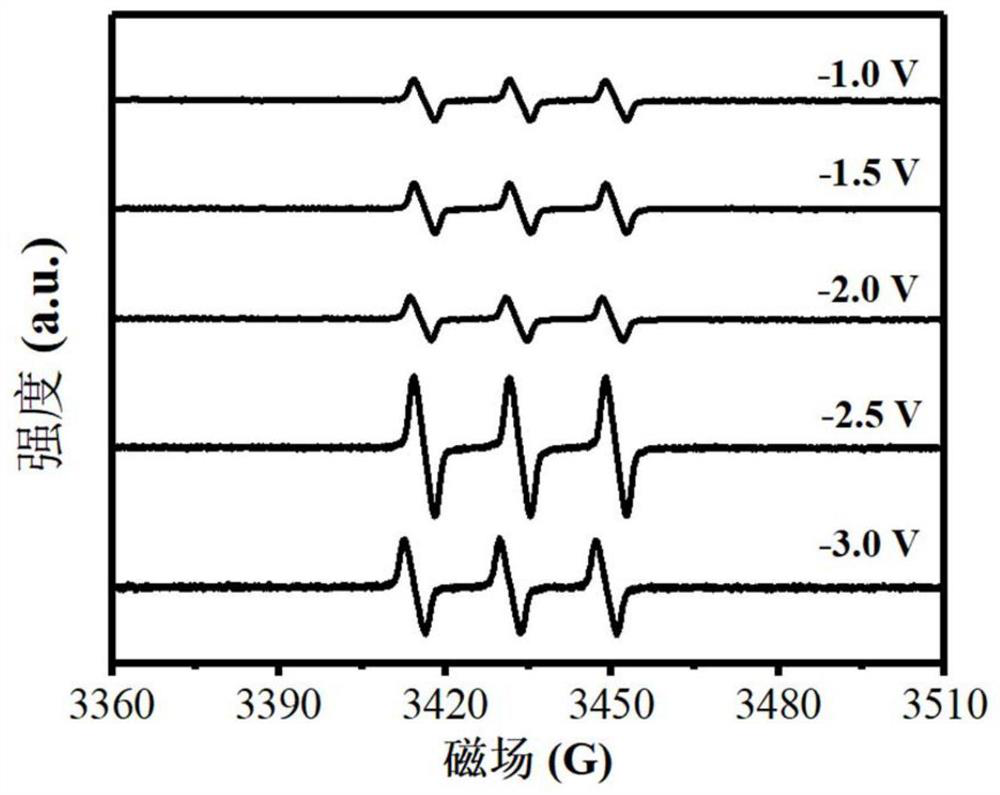Flow-through electrochemical system for selectively degrading organic pollutants based on singlet oxygen and application thereof
An electrochemical and methyl technology, applied in the field of water treatment, can solve the problems of slow reaction kinetics, increased risk, cumbersome operation process, etc., and achieve the effects of improving removal rate and efficiency, shortening reaction time, and enhancing mass transfer
- Summary
- Abstract
- Description
- Claims
- Application Information
AI Technical Summary
Problems solved by technology
Method used
Image
Examples
Embodiment 1
[0027] A method for preparing a flow-through electrochemical system for selectively degrading organic pollutants based on singlet oxygen:
[0028] (1) Dissolve 20 mg of multi-walled CNTs in 50 mL of 1-methyl-2-pyrrolidone, and disperse them by ultrasonication. Ultrasonic conditions: ultrasonic power is 100 W, and ultrasonic time is 40 min;
[0029] (2) Vacuum suction filtration of the dispersion onto a polytetrafluoroethylene support membrane with a diameter of 47 mm to obtain a CNT membrane;
[0030] (3) if figure 1 The prepared CNT filter membrane is used as the cathode (2), and the porous titanium sheet is placed as the anode (4) in a double-layer membrane filter housing. Containing 1mmol of sodium hypochlorite at a flow rate of 1mL / min figure 1 The direction of the solid arrow in the middle enters the shell of the double-layer membrane filter device, and passes through the CNT filter membrane (pH value is 7.0, and the applied voltage is 1-3V), along the figure 1 Outflow...
Embodiment 2
[0033] a based on 1 o 2 The flow-through electrochemical system selectively degrades organic dyes in water:
[0034] (1) Dissolve 20 mg of multi-walled CNTs in 40 mL of 1-methyl-2-pyrrolidone, and disperse them by ultrasonication. Ultrasonic conditions: ultrasonic power is 150 W, and ultrasonic time is 30 min;
[0035] (2) Vacuum filter the dispersion onto a polytetrafluoroethylene support membrane with a diameter of 47 mm to prepare a CNT membrane.
[0036] (3) if figure 1 The prepared CNT filter membrane is used as the cathode (2), and the porous titanium sheet is placed as the anode (4) in a double-layer membrane filter housing. Wastewater containing 30 μmol of organic dye flows along the flow rate of 1mL / min figure 1 The direction of the solid arrow in the middle enters the shell of the double-layer membrane filter device, and passes through the CNT filter membrane (pH value is 7.0, and the applied voltage is -2.5V), along the figure 1 Outflow in the direction of the ...
PUM
 Login to View More
Login to View More Abstract
Description
Claims
Application Information
 Login to View More
Login to View More - R&D
- Intellectual Property
- Life Sciences
- Materials
- Tech Scout
- Unparalleled Data Quality
- Higher Quality Content
- 60% Fewer Hallucinations
Browse by: Latest US Patents, China's latest patents, Technical Efficacy Thesaurus, Application Domain, Technology Topic, Popular Technical Reports.
© 2025 PatSnap. All rights reserved.Legal|Privacy policy|Modern Slavery Act Transparency Statement|Sitemap|About US| Contact US: help@patsnap.com



